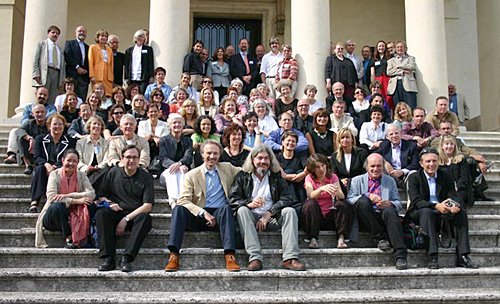The idea of a conference in Venice sounds like a dream, but it came true for the 101 delegates who attended icam12 over six sunlit Autumn days in 2004. The reality of organising such an event, moving large numbers of people around and keeping to time in a place packed with tourists, was of course another matter. Anna Tonicello and her team at the Universitá IUAV di Venezia did wonders in creating a seamless miracle of organisation as we were walked, bussed and (often) taken by boat from place to place. The conference was based in the Palazzo Badoer, its cool halls surrounding a garden, the sounds of the evening sessions drifting down from the open windows. But this was not the only architectural experience, for the organisers had contrived to link events to great architecture at every turn: the conference opened at the Palazzo Ducale, in a sala looking out to the lagoon, while the General Assembly, was quite literally staged in the Teatro Olimpico in Vicenza. It followed a lunch at the Villa La Rotonda, and was succeeded by a final dinner at the Villa Poiana. The whole event was dominated by two Venetian architectural heroes, Andrea Palladio and Carlo Scarpa, the latter incisively analysed in an opening paper by Francesco dal Co. Nor was that all, for the conference was timed to coincide with the Architecture Biennale. Delegates were taken round the exhibition by Kurt W. Forster, one of its principal organisers, and examined the phenomenon further in a session (chaired by Ulrike Jehle-Schulte Strathaus) on ‘setting a temporary event in an international context’.
As at previous icam conferences, sessions alternated with trips and visits. On one occasion there were three sessions and a visit in one day, which must be a record, even for hardened icamites determined to get the most out of their time! As has become something of a tradition at icam conferences, the sessions began with a regional overview (chaired by Antonello Alici) of architecture and architectural museums, in this case covering the Mediterranean, with reports from Turkey (the Arkitera Architecture Center, Istanbul) and Greece (the Neohellenic Architecture Archives, Athens) as well as Italy (Zaha Hadid’s MAXXI in Rome and MART in Rovereto). On the evening of the same day Ulf Grønvold led an exposition and critique of a growing phenomenon, the creation of permanent galleries of architecture, each tending to reflect its national and institutional background. The next morning Pierre Frey chaired a session devoted to the exploration of the challenges of computerised design, a continuing central concern of icam members. It included a presentation by Kristine Fallon and Martha Thorne on the important results of an investigation into capturing CAD carried out for The Art Institute of Chicago. On the next day, for the first time in icam, the conference discussed the relationship between architecture and photography, chaired by Robert Elwall and backed up by an evening technical session with the conservator Susie Clark. On the last day, in Vicenza, David Powell chaired another first for icam, a set of papers on education through museums and exhibitions, hopefully the initial step in creating a network of educators within icam. In a short report it is not possible to do justice to the events that made up the rest of a packed programme. They included visits to the extraordinary Venetian State Archive, with its miles of ancient shelves, the Fenice theatre risen again and a trip to two Scarpa monuments around Treviso; the Canova plaster cast gallery at Possagno and his great Brion Tomb at San Vito di Altivole. The 22 delegates on the postconference tour headed south, with two days in Rome and two in Naples. We experienced a memorable mixture of the ancient (Nero’s Domus Aurea and the Imperial pleasure grounds around Naples) and the 20th century. Expertly guided, we were given a unique insight, most particularly into a great range of official buildings of the 1920s and 30s. But as always with icam, the conference was much more than the events on the programme. Like the old Rialto, the Market Place stalls, Badoer Garden, buses and boats rang with the sound of experiences being swapped, deals being struck and meetings being arranged. That, after all, is what icam is all about.
michael snodin, president icam



